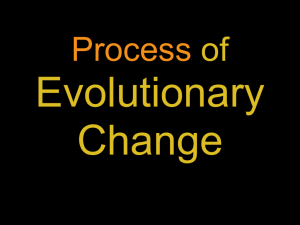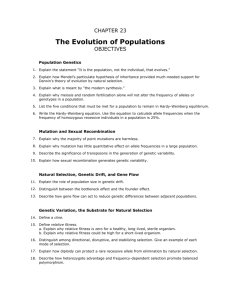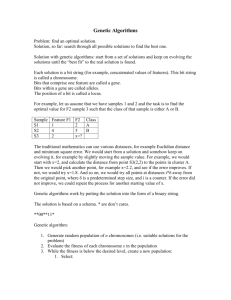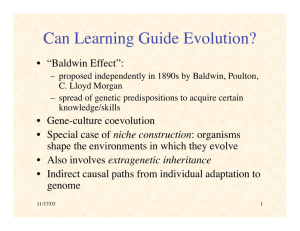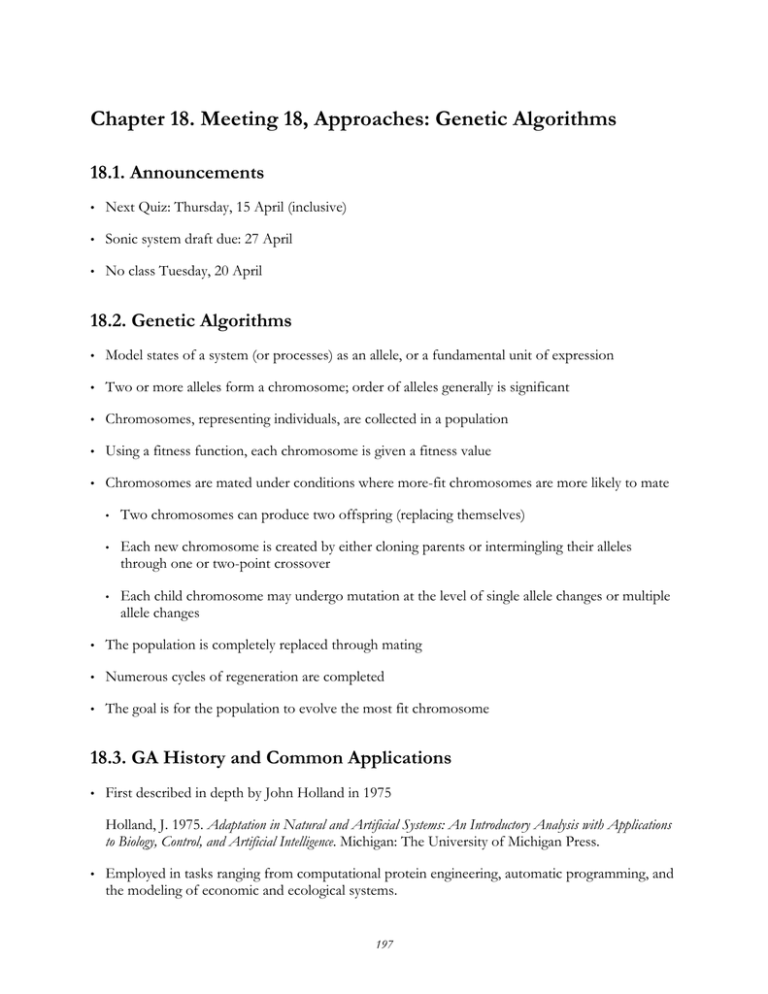
Chapter 18. Meeting 18, Approaches: Genetic Algorithms
18.1. Announcements
•
Next Quiz: Thursday, 15 April (inclusive)
•
Sonic system draft due: 27 April
•
No class Tuesday, 20 April
18.2. Genetic Algorithms
•
Model states of a system (or processes) as an allele, or a fundamental unit of expression
•
Two or more alleles form a chromosome; order of alleles generally is significant
•
Chromosomes, representing individuals, are collected in a population
•
Using a fitness function, each chromosome is given a fitness value
•
Chromosomes are mated under conditions where more-fit chromosomes are more likely to mate
•
Two chromosomes can produce two offspring (replacing themselves)
•
Each new chromosome is created by either cloning parents or intermingling their alleles through one or two-point crossover •
Each child chromosome may undergo mutation at the level of single allele changes or multiple
allele changes
•
The population is completely replaced through mating
•
Numerous cycles of regeneration are completed
•
The goal is for the population to evolve the most fit chromosome
18.3. GA History and Common Applications
•
First described in depth by John Holland in 1975
Holland, J. 1975. Adaptation in Natural and Artificial Systems: An Introductory Analysis with Applications
to Biology, Control, and Artificial Intelligence. Michigan: The University of Michigan Press.
•
Employed in tasks ranging from computational protein engineering, automatic programming, and
the modeling of economic and ecological systems.
197
•
Generally best suited for solving problems that lack rigorous definition
18.4. Encoding the Alleles and Chromosomes
•
Many GA designs use binary encoding: 1s and 0s encode desired parameters
•
Real-value encoding uses an alphabet of many characters or real numbers
•
Many GAs use fixed length chromosomes
18.5. Mutations
•
•
Binary GAs often perform bit-level manipulations
•
Bits can be flipped
•
Segments of bits can be deleted, repeated, or reversed
Domain-specific GA mutations are possible
18.6. The Fitness Function and Finding Solutions
•
The fitness function is the key
•
The fitness function expresses the priorities of the system
•
GAs can evolve toward a local fitness yet get stuck, not reaching the maximum fitness
•
Some systems have employed human-mediated fitness evaluation
18.7. A GA of Pulse Triple Chromosomes
•
Project conducted in 2001-2002
Ariza, C. 2002. “Prokaryotic Groove: Rhythmic Cycles as Real-Value Encoded Genetic
Algorithms.” In Proceedings of the International Computer Music Conference. San Francisco: International
Computer Music Association. 561-567. Internet: http://www.flexatone.net/docs/pgrcrvega.pdf.
•
First design for sub-system models in athenaCL, exposed through ParameterObjects
•
Alleles are pulse triples
•
Chromosome is a sequence of alleles where order is musically performed order
•
Fitness function is based on similarity to a target chromosome
198
•
Find temporal distance of note durations, rest durations, and total duration (larger values mean
greater distance)
•
Find weighted duration of non-matched alleles (non-exact pulse triple matches, where count is
multiplied by average allele duration)
•
Find weighted duration of non-matched duration ratios (non matching pulse triple ratios, where count is multiplied by average allele duration)
•
Sum of these values weighted with values found through experiment: noteDistance*1.50, restDistance*1.50, durDistance*2.33, noMatchAlleleDistance*1.00, noMatchValueDistance*0.66.
•
An inverse relation: the larger the value, the greater the distance from the target
•
Two point crossover employed in mating
•
Mutations are specific to pulse triples
•
Ratio equivalence: multiply or divide divisor or multiplier by 2 or 3
•
Divisor mutate: add or subtract 1 to divisor
•
Multiplier mutate: add or subtract 1 to multiplier
•
Flip note/rest state
•
Inversion: select to lic, reverse the segment with the retrograde of the segment
•
Population is initialized through random arrangements of pulse triples found in the source
•
For each generation, retain the chromosome that is the best fit (and is unique)
•
After generations are complete, order best-fit chromosomes by fitness
•
Example: python genetic.py
18.8. GA as ParameterObject
•
The gaRhythm ParameterObject
:: tpv garhythm
Rhythm Generator ParameterObject
{name,documentation}
GaRhythm
gaRhythm, pulseList, crossover, mutation, elitism,
selectionString, populationSize
Description: Uses a genetic algorithm to create rhythmic
variants of a source rhythm. Crossover rate is a percentage,
expressed within the unit interval, of genetic crossings
that undergo crossover. Mutation rate is a percentage,
expressed within the unit interval, of genetic crossings
199
that undergo mutation. Elitism rate is a percentage,
expressed within the unit interval, of the entire population
that passes into the next population unchanged. All rhythms
in the final population are added to a list. Pulses are
chosen from this list using the selector specified by the
control argument. Arguments: (1) name, (2) pulseList {a list
of Pulse notations}, (3) crossover, (4) mutation, (5)
elitism, (6) selectionString {“randomChoice”, “randomWalk”,
“randomPermutate”, “orderedCyclic”,
“orderedCyclicRetrograde”, “orderedOscillate”}, (7) populationSize
18.9. Evolving African Drum Patterns with a GA
•
Slow Agbekor (Chernoff 1979)
© University of Chicago Press. All rights reserved. This content is excluded from
our Creative Commons license. For more information, see http://ocw.mit.edu/fairuse.
•
Command sequence 1: exploring two durations:
•
emo mp
•
tmo lg
200
•
tin a 61
•
bell line, set to loop
tie r l,[(4,4,1),(4,4,1),(4,2,1),(4,4,1),(4,4,1),(4,4,1),(4,2,1)]
•
accent the first of each articulation
tie a bg,oc,(1,.5,.5,.5,.5,.5,.5)
•
tin b 68
•
create genetic variations using a high mutation rate
tie r gr,[(4,4,1),(4,4,1),(4,2,1),(4,4,1),(4,4,1),(4,4,1),(4,2,1)],.7,.25,0
•
•
tie a bg,oc,(1,.5,.5,.5,.5,.5,.5)
•
eln; elh
Command sequence 2: combinations of rests and silences
•
emo mp
•
tmo lg
•
tin a 61
•
kagan line, set to loop
tie r l,[(4,2,0),(4,2,1),(4,2,1),(4,2,0),(4,2,1),(4,2,1),(4,2,0), (4,2,1),(4,2,1),(4,2,0),(4,2,1),(4,2,1)]
•
accent the first of each articulation
tie a bg,oc,(.5,1,.5, .5,.5,.5, .5,.5,.5, .5,.5,.5)
•
turning on silence mode will use parameters even for rests
timode s on
•
tin b 68
•
create genetic variations using a high crossover, no mutation
tie r gr,[(4,2,0),(4,2,1),(4,2,1),(4,2,0),(4,2,1),(4,2,1),(4,2,0), (4,2,1),(4,2,1),(4,2,0),(4,2,1),(4,2,1)],1,0,0
•
tie a bg,oc,(.5,1,.5, .5,.5,.5, .5,.5,.5, .5,.5,.5)
•
turning on silence mode will use parameters even for rests
201
timode s on
•
•
eln; elh
Command sequence 3: multiple rhythmic values:
•
emo mp
•
tmo lg
•
tin a 61
•
kroboto line, set to loop
tie r l,[(4,3,1),(4,1,1),(4,2,1),(4,2,1),(4,1,1),(4,1,1),(4,2,1), (4,3,1),(4,1,1),(4,2,1),(4,2,1),(4,1,1),(4,1,1),(4,2,1)]
•
accent the first of each articulation
tie a bg,oc,(1,.5,.5,.5,.5,.5,.5,.5,.5,.5,.5,.5,.5,.5)
•
tin b 68
•
create genetic variations using a high crossover and mutation rate and some elitism
tie r gr,[(4,3,1),(4,1,1),(4,2,1),(4,2,1),(4,1,1),(4,1,1),(4,2,1), (4,3,1),(4,1,1),(4,2,1),(4,2,1),(4,1,1),(4,1,1),(4,2,1)],.9,.25,0.1
•
tie a bg,oc,(1,.5,.5,.5,.5,.5,.5,.5,.5,.5,.5,.5,.5,.5)
•
eln; elh
18.10. Polyphonic African Drum Patterns with a GA
•
Slow Agbekor (Chernoff 1979)
202
© University of Chicago Press. All rights reserved. This content is excluded from our
Creative Commons license. For more information, see http://ocw.mit.edu/fairuse.
•
Command sequence:
•
emo mp
•
tmo lg
•
tin a 45
•
tie r gr,[(4,4,1),(4,4,1),(4,2,1),(4,4,1),(4,4,1),(4,4,1),(4,2,1)],.7,.15,0
•
tie a bg,oc,(1,.5,.5,.5,.5,.5,.5)
•
tin b 60
•
create genetic variations using a high crossover, no mutation
tie r gr,[(4,2,0),(4,2,1),(4,2,1),(4,2,0),(4,2,1),(4,2,1),(4,2,0),
(4,2,1),(4,2,1),(4,2,0),(4,2,1),(4,2,1)],1,0,0
•
tie a bg,oc,(.5,1,.5, .5,.5,.5, .5,.5,.5, .5,.5,.5)
203
•
turning on silence mode will use parameters even for rests
timode s on
•
tin c 68
•
create genetic variations using a high crossover and mutation rate and some elitism
tie r gr,[(4,3,1),(4,1,1),(4,2,1),(4,2,1),(4,1,1),(4,1,1),(4,2,1), (4,3,1),(4,1,1),(4,2,1),(4,2,1),(4,1,1),(4,1,1),(4,2,1)],.9,.25,0.1
•
tie a bg,oc,(1,.5,.5,.5,.5,.5,.5,.5,.5,.5,.5,.5,.5,.5)
•
eln; elh
18.11. Reading: Biles, GenJam in Perspective: A Tentative Taxonomy
for GA Music and Art Systems
•
Biles, J. A. 2003. “GenJam in Perspective: A Tentative Taxonomy for GA Music and Art
Systems.” Leonardo 36(1): 43-45.
•
What are the alleles and chromosomes in this study?
•
At what level of the chromosome do the mutations operate? What types of mutations are used
•
How is fitness measured?
•
How does the concept of “musically meaningful mutations” deviate from conventional GAs?
•
Which does the author suggest are more solution-rich: artistic domains or non-artistic domains?
18.12. GenJam Example
•
Video: Demonstration created in 2003
18.13. Reading: Magnus, Evolving electroacoustic music: the
application of genetic algorithms to time-domain waveforms
•
Magnus, C. 2004. “Evolving electroacoustic music: the application of genetic algorithms to timedomain waveforms.” In Proceedings of the International Computer Music Conference. San Francisco:
International Computer Music Association. 173-176.
204
•
What are the alleles and chromosomes in this study?
•
What types of mutations were explored in this study?
•
Is there a distinction between genotype and phenotype?
•
The author writes: “at each stage of programming, choices must be made that introduce designer
bias into the system”; it this a problem?
205
MIT OpenCourseWare
http://ocw.mit.edu
21M.380 Music and Technology: Algorithmic and Generative Music
Spring 2010
For information about citing these materials or our Terms of Use, visit: http://ocw.mit.edu/terms.




